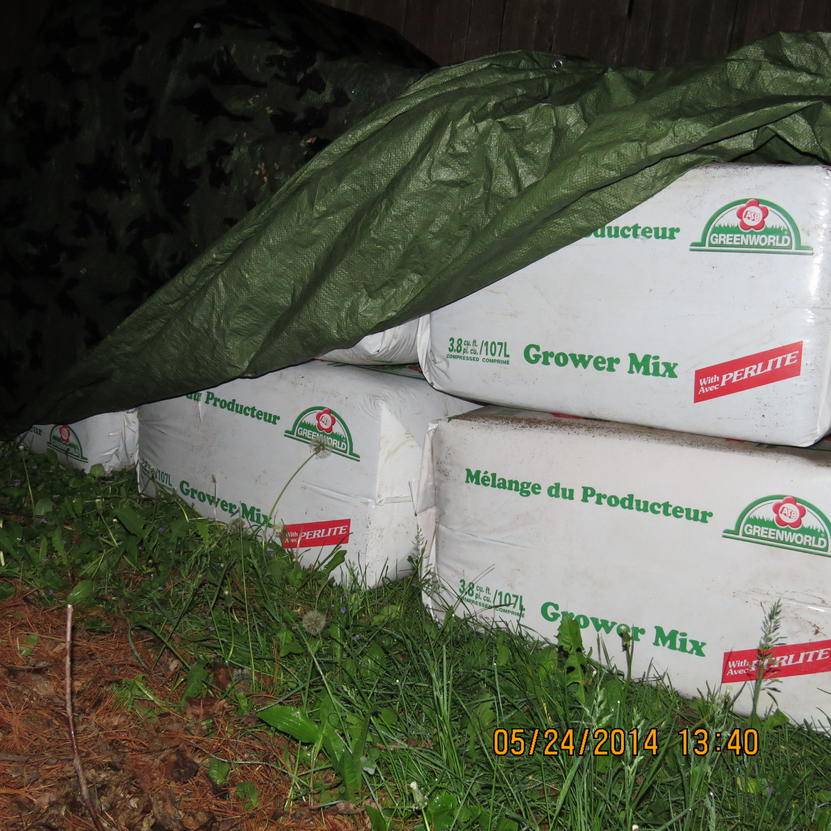^ The mix BigWillyDee suggests is spot on in terms of ratios. I remember reading something like the ideal balance is 1:1:1 for peat:compost:aeration
After trying this mix out myself, I realized it's spot on.
This is what I use indoors and out, and it's brought me great success thus far:
Soil Mix:
1 pt. Peat Moss
1 pt. Rice Hull
1 pt. Compost
Mixed with:
Acadian Kelp Meal @ 1/2 Cup per cubic foot
Neem Cake and Karanja Cake 50/50 Mix @ 1/2 cup per cubic foot
Crustacean Meal @ 1/2 cub per cubic foot
Gypsum Dust @ 1 Cup Per Cubic Foot
Brix Blend Basalt @ 1 Cup Per Cubic Foot
Glacial Rock Dust @ 1 Cup Per Cubic Foot
Oyster Flour @ 1 Cup Per Cubic Foot
If native soil is rich enough I'll cut this with the peat moss 50:50, and save some time while hauling bales. This kick starts the biology in the holes as well, and when I add the amendments in the form of a nutrient pack (all mixed together in a big bag) they'll break down faster in these 1/2 native soil 1/2 peat moss holes. About 45 days before transplanting, I'll haul bales of peat moss out to each site, and stash them under some brush until I bring the 7 cubic ft bales of rice hulls out.

10 bales hidden under some brush for this swamp grow

Safe from the rain until mixing day. Bales of peat become 10x as heavy when wet I've learned (the hard way), so it's important to keep them dry while they're at drop sites.

Getting ready to mix up a hole deep in the swamp
Once the payloads are hauled I'll bring the nutrient pack along with a camo tarp in a backpack, and start mixing soil and filling holes. I'll cover them with anything native that can be used as mulch, water, and let nature run it's course for a good month or so. When I come back I'll have rich soil that can be directly planted into. If I didn't wait and planted right away it would burn the clones and yields would be diminished dramatically. It always pays to get out there early enough to let mixes like these compost down.

Filled with equal parts peat/compost/aeration and topped off some bokashi before the first watering

Topped off with native grass which now that I look back - was way too bright to be used as mulch in this area. The grass is green and this stuff is not lol. I think I'll cover this with green foliage or plant cover crops here this year instead...
But that's it, keep it simple and dig deep holes for big yields. These holes are just under 90 gallons, since each 3.8 cu. ft. peat bale comes to about 28 gallons. Use native soil when possible, and always, always mulch!
After trying this mix out myself, I realized it's spot on.
This is what I use indoors and out, and it's brought me great success thus far:
Soil Mix:
1 pt. Peat Moss
1 pt. Rice Hull
1 pt. Compost
Mixed with:
Acadian Kelp Meal @ 1/2 Cup per cubic foot
Neem Cake and Karanja Cake 50/50 Mix @ 1/2 cup per cubic foot
Crustacean Meal @ 1/2 cub per cubic foot
Gypsum Dust @ 1 Cup Per Cubic Foot
Brix Blend Basalt @ 1 Cup Per Cubic Foot
Glacial Rock Dust @ 1 Cup Per Cubic Foot
Oyster Flour @ 1 Cup Per Cubic Foot
If native soil is rich enough I'll cut this with the peat moss 50:50, and save some time while hauling bales. This kick starts the biology in the holes as well, and when I add the amendments in the form of a nutrient pack (all mixed together in a big bag) they'll break down faster in these 1/2 native soil 1/2 peat moss holes. About 45 days before transplanting, I'll haul bales of peat moss out to each site, and stash them under some brush until I bring the 7 cubic ft bales of rice hulls out.
10 bales hidden under some brush for this swamp grow
Safe from the rain until mixing day. Bales of peat become 10x as heavy when wet I've learned (the hard way), so it's important to keep them dry while they're at drop sites.
Getting ready to mix up a hole deep in the swamp
Once the payloads are hauled I'll bring the nutrient pack along with a camo tarp in a backpack, and start mixing soil and filling holes. I'll cover them with anything native that can be used as mulch, water, and let nature run it's course for a good month or so. When I come back I'll have rich soil that can be directly planted into. If I didn't wait and planted right away it would burn the clones and yields would be diminished dramatically. It always pays to get out there early enough to let mixes like these compost down.
Filled with equal parts peat/compost/aeration and topped off some bokashi before the first watering
Topped off with native grass which now that I look back - was way too bright to be used as mulch in this area. The grass is green and this stuff is not lol. I think I'll cover this with green foliage or plant cover crops here this year instead...
But that's it, keep it simple and dig deep holes for big yields. These holes are just under 90 gallons, since each 3.8 cu. ft. peat bale comes to about 28 gallons. Use native soil when possible, and always, always mulch!


